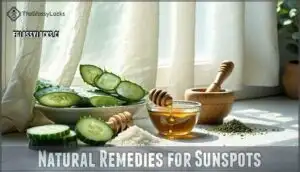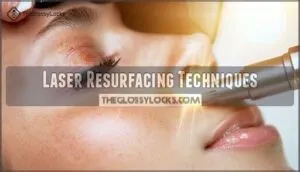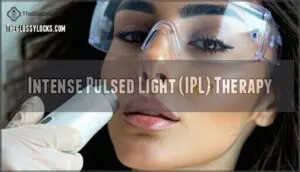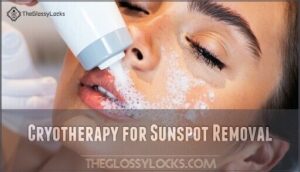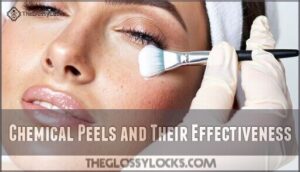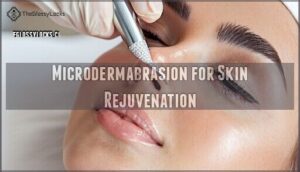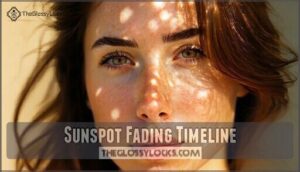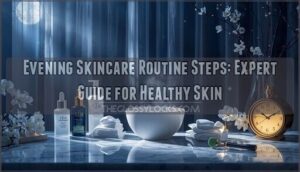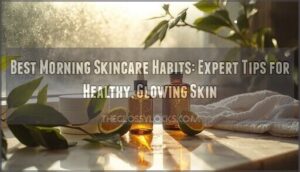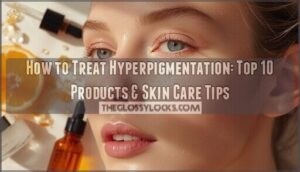This site is supported by our readers. We may earn a commission, at no cost to you, if you purchase through links.
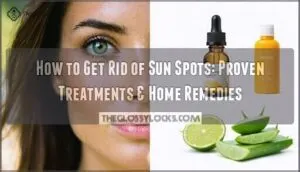
Start with topical treatments like vitamin C serums, retinoids, or hydroquinone creams, which gradually fade spots over 8-12 weeks.
Professional options include laser therapy, chemical peels, and IPL treatments that deliver faster results in 4-6 weeks.
Natural remedies like aloe vera and licorice extract offer gentler alternatives.
Consistency is key – apply treatments daily while using broad-spectrum SPF 30+ sunscreen to prevent new spots from forming.
The good news? Most people see noticeable improvement within a month of starting treatment, though deeper spots may take longer to fade completely.
Table Of Contents
- Key Takeaways
- What Are Sunspots
- Get Rid of Sun Spots
- Natural Remedies for Sunspots
- Professional Sunspot Removal
- Preventing Future Sunspots
- Sunspot Fading Timeline
- Frequently Asked Questions (FAQs)
- How do you get rid of sunspots?
- How do you lighten dark sunspots?
- How do I get rid of sun spots on my face?
- What is the best treatment for sun spots?
- Can sun spots be prevented?
- How can a dermatologist remove sun spots?
- Is it possible to get rid of sunspots?
- How do Koreans get rid of sunspots?
- How long does it take for sun spots to fade?
- Can sun spots be healed?
- Conclusion
Key Takeaways
- Start with topical treatments – You’ll see noticeable improvement in 4-12 weeks using vitamin C serums, retinoids, or hydroquinone creams applied daily to gradually break down melanin buildup.
- Consider professional procedures for faster results – Laser therapy, chemical peels, and IPL treatments can fade stubborn spots in 2-6 weeks, though they’re more expensive than at-home options.
- Prevention is crucial for long-term success – You must wear broad-spectrum SPF 30+ sunscreen daily and reapply every two hours to prevent new spots from forming while treating existing ones.
- Natural remedies work but require patience – Aloe vera, licorice extract, and vitamin C offer gentler alternatives that take 2-6 months of consistent daily application to show significant fading results.
What Are Sunspots
You’ll immediately recognize sunspots as flat, brown patches that appear on your skin after years of sun exposure, particularly if you’re over 40 or have fair skin.
These harmless yet cosmetically concerning spots develop when UV radiation causes melanin to accumulate in specific areas, creating darker pigmentation than your surrounding skin tone, which can be a sign of sun exposure.
UV rays don’t just tan your skin—they create permanent dark patches that age you faster than time itself.
Causes of Sunspots
Several factors trigger sun spots formation on your skin, with prolonged UV exposure being the primary culprit that accelerates melanin production in specific areas.
- UV radiation from sun exposure causes melanocytes to multiply and produce excess pigment
- Age factors increase susceptibility as skin becomes less resilient over time
- Skin type determines vulnerability, with fair complexions showing damage more readily
- Genetic predisposition influences how your skin responds to UV rays and sun damage
- Cumulative exposure builds up over years, eventually manifesting as visible sun spots
Characteristics of Sunspots
Sunspots appear as flat, dark patches on your skin, ranging from light brown to black in color.
These solar lentigines develop when UV radiation triggers melanocytes to produce excess melanin buildup, creating visible skin discoloration.
Spot appearance varies in size and intensity, with spot prevalence increasing after age 40 when over 90% of people develop at least one through cumulative UV exposure.
Common Areas for Sunspot Development
Your face bears the brunt of daily sun exposure, making facial sunspots the most common form of skin discoloration.
Your face takes the biggest hit from daily sun damage, making it sunspot central for most people.
Hand pigmentation follows closely, as your hands remain uncovered during outdoor activities.
Shoulder spots and arm discoloration develop from tank tops and sleeveless clothing, while back sunspots emerge from swimming and sunbathing, creating widespread hyperpigmentation requiring targeted sun damage repair treatments, which address the issue of skin discoloration.
Differentiating Sunspots From Other Skin Conditions
Correctly identifying whether you’re dealing with a mole or sunspot requires careful observation of key characteristics.
True sunspots appear flat and uniformly brown, while melanoma detection involves checking for asymmetry, irregular borders, and color variations.
Unlike freckles vs. sunspots, which both result from sun exposure, seborrheic keratosis appears raised and waxy. Actinic keratosis feels rough and scaly, requiring dermatologist evaluation for potential skin cancer risks in these skin lesions.
Get Rid of Sun Spots
Now that you understand what sunspots are and how they form, you’re probably wondering how to tackle these stubborn dark patches.
The good news? You’ve got plenty of options for sun spots removal, from gentle home remedies to professional hyperpigmentation treatment methods.
Here are five effective approaches to fade sun spots:
- Topical treatments – Over-the-counter creams containing kojic acid or hydroquinone for dark spots correction
- Professional procedures – Laser therapy, chemical peels, and IPL for faster sun damage repair
- Natural remedies – Vitamin C serums, aloe vera, and lemon juice applications
- Combination therapy – Using multiple methods together for enhanced results
- Maintenance protocols – Consistent skincare routines to prevent spot recurrence
Treatment costs vary widely, from affordable home remedies to expensive professional sessions.
Pain management is typically minimal with most procedures, though some may cause temporary discomfort.
While scarring risks are low with proper care, it’s important to follow aftercare instructions carefully to avoid complications and promote maximal healing.
For enhanced results, consider incorporating natural antioxidants stimulate collagen production.
Natural Remedies for Sunspots
If you’re looking for gentle alternatives to harsh chemical treatments, several natural ingredients can help lighten sunspots over time.
These remedies work by reducing melanin production or gently exfoliating damaged skin cells, though they require consistent application for several weeks to show results.
Aloe Vera for Sunspot Lightening
You can harness aloe vera’s natural sun spots removal power through its active aloe compounds like aloesin and aloin, which target hyperpigmentation treatment effectively.
Apply fresh gel or pure aloe vera extract twice daily for natural remedies that work.
Explore various aloe vera sunspots products for enhanced results.
Treatment duration typically spans several months for skin lightening results, though aloe side-effects remain minimal with expected results showing gradual improvement.
Licorice Extract as a Natural Skin Brightener
Traditionally, licorice extract serves as one of nature’s most effective skin brightening solutions for targeting stubborn sunspots.
This natural remedy contains glabridin, which inhibits melanin production while liquiritin helps disperse existing pigmentation.
Apply topical treatments containing 0.5-2% licorice extract twice daily for the best hyperpigmentation remedies.
The safety profile remains excellent, making it suitable for sensitive skin seeking gentle natural remedies.
Vitamin C and E for Skin Repair
Vitamin C and E work together as powerful antioxidants to repair skin damage and lighten sunspots.
You’ll find vitamin C benefits include protecting against UV rays and promoting collagen production, while vitamin E benefits focus on cellular repair.
Apply topical treatments containing both vitamins daily, or consider supplement efficacy through dietary sources, including Antioxidant-rich foods that can also aid in the fight against free radicals.
This antioxidant synergy accelerates skin damage repair through consistent topical application.
Apple Cider Vinegar Treatment Methods
Apple cider vinegar’s acetic acid works like nature’s gentle bleach for stubborn skin spots.
Mix one part ACV with two parts water for safe ACV dilutions that won’t irritate sensitive skin.
Apply this at-home treatment using a cotton ball twice daily, leaving it on for two hours before rinsing.
Most people see gradual skin pigmentation improvements after 6-8 weeks of consistent application frequency, though skin sensitivity varies between individuals.
Dietary Changes to Support Skin Health
Your body needs nutritional support to heal sun damage from within.
Boost your Antioxidant Intake with berries, leafy greens, and citrus fruits—these Skin-Boosting Foods neutralize free radicals that worsen sunspots.
Prioritize Hydration Importance by drinking eight glasses daily; well-hydrated skin repairs faster.
Avoid Inflammatory Foods like processed sugars that slow healing, while addressing any Vitamin Deficiency through omega-3 rich fish and nuts for superior skin health.
Professional Sunspot Removal
When at-home remedies aren’t cutting it, professional treatments offer faster and more dramatic results for stubborn sunspots.
These medical procedures target pigmentation at deeper levels, giving you clearer skin in weeks rather than months, which can lead to more dramatic results.
Laser Resurfacing Techniques
Laser resurfacing delivers precision when you’re ready to say goodbye to stubborn sun spots.
This advanced dermatological procedure uses concentrated light beams to remove damaged skin layers, revealing fresh tissue underneath.
Laser Types available include:
- CO2 lasers – Ablative treatment for dramatic results
- Er:YAG lasers – Controlled ablation with minimal downtime
- Fractional lasers – Microbeam technology reducing risks
- Picosecond lasers – Ultra-short pulses for enhanced clearance
- Hybrid platforms – Combined wavelengths for superior rejuvenation
Recovery Timeline spans 10-21 days, while Treatment Cost varies by laser type.
Expected Results show over 75% lesion clearance after two sessions, though Risks Involved include temporary redness and rare pigmentation changes.
Many patients find that lasers like BBL address redness in addition to sunspots.
Intense Pulsed Light (IPL) Therapy
Intense pulsed light (IPL) delivers broad-spectrum light energy to target melanin in sunspots without damaging surrounding tissue.
This dermatological procedure works best on fair to medium skin types, achieving up to 70% pigmentation reduction.
You’ll typically need three to six sessions spaced monthly apart.
While IPL carries minimal risks like temporary redness, proper sun protection afterward prevents hyperpigmentation complications.
The treatment can also address issues like rosacea and age spots, providing a solution for various skin concerns with minimal risks.
Cryotherapy for Sunspot Removal
Cryotherapy freezes sunspots using liquid nitrogen or alternative cryogens like nitrous oxide, creating controlled frostbite that destroys pigmented cells.
This dermatological procedure typically costs $50-200 per session.
Key procedure details:
- Treatment takes 10-30 seconds per spot
- Mild stinging sensation during application
- Scabbing occurs within days, healing in 1-2 weeks
Post-treatment care involves keeping areas clean and avoiding sun exposure to prevent complications and optimize results.
Chemical Peels and Their Effectiveness
When you’re ready to tackle stubborn sunspots, chemical peels offer proven results that natural remedies can’t match.
These dermatological procedures use glycolic acid and other targeted compounds to remove damaged skin layers, effectively reducing skin hyperpigmentation.
Peel strength determines your downtime expectations—lighter treatments require minimal recovery while deeper peels need up to two weeks.
Treatment frequency varies by skin types, with most patients seeing dramatic improvement after 2-4 sessions.
Potential risks include temporary redness and skin peeling, making professional consultation essential.
Chemical peels also help to improve skin tone.
Microdermabrasion for Skin Rejuvenation
Microdermabrasion gently buffs away your skin’s top layer using tiny crystals or a diamond-tipped wand.
This dermatological procedure offers excellent benefits for age spots removal and skin hyperpigmentation, requiring minimal treatment downtime.
You’ll see expected results after three sessions, with smooth skin rejuvenation becoming visible, and maintenance therapy guarantees lasting improvements in your complexion’s brightness and texture.
Cost analysis shows it’s more affordable than laser treatments.
Preventing Future Sunspots
Once you’ve treated existing sunspots, preventing new ones becomes essential for maintaining clear, healthy skin.
You’ll need to adopt consistent sun protection habits that shield your skin from harmful UV radiation every single day to ensure healthy skin.
Importance of Daily Sunscreen Application
Daily sunscreen application forms your strongest defense against future sun damage and sunspot formation.
Consistent UVA and UVB protection prevents melanin overproduction that creates these unwanted marks. Luckily, you can easily find a daily sunscreen SPF that suits your needs.
Essential sunscreen practices include:
- Application Consistency – Apply broad-spectrum SPF 30+ every morning, rain or shine
- Reapplication Frequency – Reapply every two hours for continuous protection
- Sunscreen Ingredients – Choose zinc oxide or titanium dioxide for sensitive skin
Protective Clothing and Accessories
Beyond sunscreen protection, your clothing choices create powerful barriers against harmful UVA and UVB rays.
Fabric Matters – tightly woven materials block more radiation than loose weaves. Look for UPF Ratings of 30+ on garments.
Wide-brimmed Hat Styles provide essential Coverage Area for your face and neck.
Quality Sunglass Protection shields delicate eye areas where prevent sun spots efforts often fall short.
Optimal Times for Sun Exposure
Time your sun exposure wisely to prevent sun spots while getting essential Vitamin D.
Check the UV Index before heading outdoors—levels below 3 are safest.
Morning hours before 10 AM and late afternoon after 4 PM offer gentler rays.
Your skin type and latitude impact ideal timing.
Fair-skinned individuals need shorter exposure periods than darker skin tones for adequate sunscreen protection effectiveness to ensure essential safety.
Long-term Effects of UV Radiation on Skin
Years of UV radiation exposure create a cascade of cumulative skin damage that goes far beyond sunspots.
This invisible assault triggers premature aging through collagen breakdown, accelerates melanin production irregularities, and substantially increases cancer risk.
Understanding these long-term consequences helps you recognize why today’s sun protection choices directly impact your skin’s future health and appearance, and it is crucial for preventing cancer risk.
Building a Sun-Safe Skincare Routine
Building your skin care routine around sun protection starts with selecting the right SPF for your skin type.
Apply broad-spectrum sunscreen daily, even indoors, and reapply every two hours.
Choose antioxidant-rich products that complement UV protection.
Routine consistency makes all the difference in preventing future sunspots and skin damage.
Sunspot Fading Timeline
Understanding your sunspot treatment timeline helps set realistic expectations for clear results.
Whether you choose natural remedies or professional procedures, knowing what to expect makes the journey to clearer skin much more manageable, and helps in achieving clearer skin.
Expectations for At-Home Treatment Results
At-home treatments require patience and realistic timelines for visible results.
Natural remedies like aloe vera and vitamin C typically show gradual changes after 6-12 weeks of consistent daily application.
Over-the-counter treatments work faster but still need 4-8 weeks.
Consistency matters more than intensity—skipping applications delays progress.
Treatment limitations mean complete spot removal isn’t always possible, and spot recurrence can happen without sun protection.
Healing Process After Professional Interventions
Professional sunspot treatments trigger predictable healing phases you’ll navigate over several weeks.
Redness duration spans 4-14 days after laser treatment or intense pulse light IPL procedures, while swelling peaks within 72 hours.
Treatment aftercare prevents scarring risks through gentle cleansing and strict sun protection.
Pigment changes occur as spots darken before lightening, signaling proper skin healing during professional treatments recovery.
Factors Affecting Sunspot Fading Speed
Your skin type plays a major role in skin spot fading speed. Fair skin typically responds faster to treatment methods than darker skin tones.
Age factors also matter—younger skin regenerates quicker. Product consistency and sun exposure habits directly impact skin spot treatment effectiveness and results.
- Skin type determines melanin response – Fair skin shows quicker skin spot treatment results than darker complexions due to lower baseline melanin levels
- Treatment method intensity affects timeline – Laser treatments work faster than topical creams, but healing varies by individual skin sensitivity
- Age factors influence cellular turnover – Younger skin regenerates every 28 days while mature skin takes 40-50 days, affecting skin spot fading rates
- Sun exposure habits impact progress – Continued UV exposure during treatment slows skin spot management and can worsen existing spots
- Product consistency determines outcome – Daily application of treatments shows better skin spot treatment effectiveness than sporadic use
Signs of Improvement in Skin Appearance
Within weeks, you’ll notice spot size reduction and color lightness as melanin breaks down.
Texture improvement becomes visible as dead skin cells shed, revealing smoother surfaces.
Even skin tone emerges gradually through consistent skin spot treatment results.
Reduced inflammation signals healing progress, while skin spot fading creates natural skin spot lightening patterns across affected areas.
Regular sunscreen use helps prevent further UV damage to achieve complete concepts of skin repair and maintain a healthy skin tone with consistent skin spot treatment.
Maintenance Strategies for Long-Term Results
Once you’ve achieved clearer skin, maintaining those results requires ongoing commitment to proven strategies.
Your skin care routine becomes your best defense against new spots forming.
Maintenance essentials for lasting results:
- Consistent Skincare: Apply broad-spectrum sunscreen daily and reapply every two hours outdoors
- Preventative Measures: Wear UV-blocking clothing and seek shade during peak sun hours (10am-4pm)
- Healthy Lifestyle: Schedule regular checkups with your dermatologist and maintain antioxidant-rich nutrition for superior skin protection
Frequently Asked Questions (FAQs)
How do you get rid of sunspots?
You can remove sunspots using laser treatments, chemical peels, or cryotherapy from dermatologists.
At-home options include vitamin C serums, retinoids, or natural remedies like aloe vera and lemon juice applied consistently.
How do you lighten dark sunspots?
Like morning mist dissolving under sunlight, you can lighten dark sunspots through consistent care. Apply vitamin C serum, use gentle chemical peels, or try laser treatments for faster results.
How do I get rid of sun spots on my face?
You can treat facial sunspots with professional laser therapy, chemical peels, or cryotherapy for fastest results.
At-home options include vitamin C serums, retinoids, or natural remedies like aloe vera and lemon juice applied consistently.
What is the best treatment for sun spots?
Professional laser treatments and chemical peels offer the most effective results for stubborn sun spots. IPL therapy targets melanin directly, while prescription hydroquinone creams provide reliable lightening over time.
Can sun spots be prevented?
Prevention is your skin’s best defense against these unwelcome visitors.
You’ll prevent sun spots by wearing SPF 30+ sunscreen daily, seeking shade during peak hours, and sporting protective clothing and wide-brimmed hats outdoors.
How can a dermatologist remove sun spots?
Dermatologists remove sun spots through several professional treatments.
Laser resurfacing destroys pigmented cells, chemical peels remove damaged skin layers, cryotherapy freezes spots off, and IPL targets melanin with light pulses effectively.
Is it possible to get rid of sunspots?
Like stubborn stains on your favorite shirt, sunspots can absolutely be eliminated.
You’ve got options ranging from gentle home remedies like vitamin C serums to professional laser treatments that zap them away completely.
How do Koreans get rid of sunspots?
Koreans use vitamin C serums, niacinamide, and alpha arbutin from traditional Hanbang ingredients. They favor gentle brightening agents like tranexamic acid and centella asiatica for effective spot treatment.
How long does it take for sun spots to fade?
Natural remedies typically take 2-6 months with consistent daily application. Professional treatments like laser therapy show results in 2-4 weeks, while chemical peels need 4-8 weeks for full fading.
Can sun spots be healed?
Unlike your grandmother’s cold cream remedies, sun spots can’t be completely "healed" since they’re permanent pigmentation changes.
However, you can effectively fade them using treatments like laser therapy, chemical peels, or topical lightening agents to restore more even skin tone, and this can be considered a way to restore.
Conclusion
Sarah noticed her first sun spot at 32 after years of beach vacations without proper sun protection.
Within six months of consistent vitamin C serum use and daily SPF application, the dark patch had faded substantially.
Understanding how to get rid of sun spots empowers you to take control of your skin’s appearance.
Whether you choose natural remedies like aloe vera or professional treatments like laser therapy, consistency remains vital.
Start your treatment plan today and protect your investment with daily sunscreen to prevent new spots from forming.
- https://www.thefergusonclinic.com/which-is-better-erbium-yag-laser-vs-co2-laser/
- https://www.mayoclinic.org/tests-procedures/laser-resurfacing/about/pac-20385114
- https://www.skinloft.com/what-are-the-latest-advancements-in-laser-sun-spot-removal-available-in-2025/
- https://onlinelibrary.wiley.com/doi/10.1155/2023/2070560
- https://skindcderm.com/laser-treatments-for-sunspots-and-redness/

